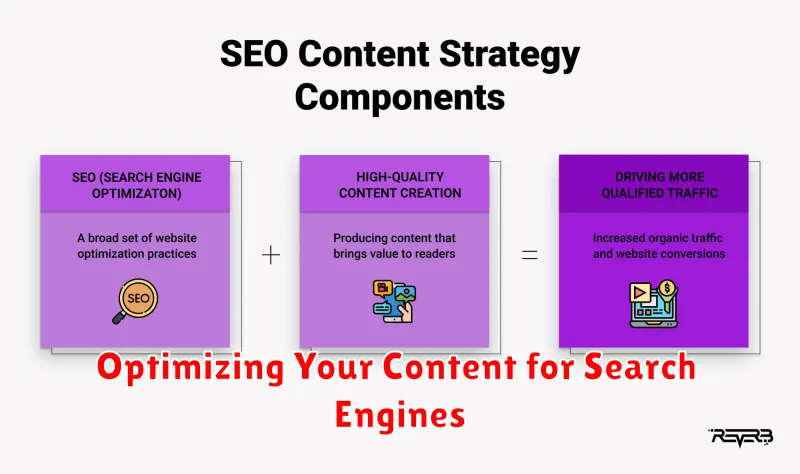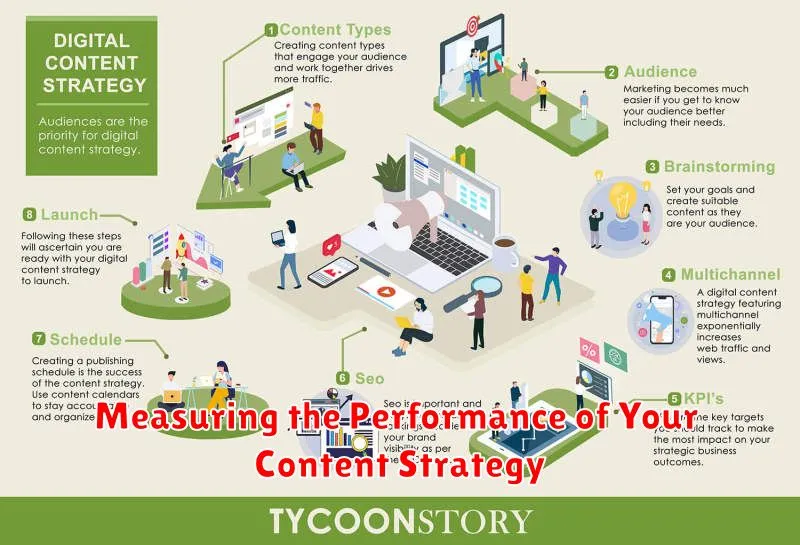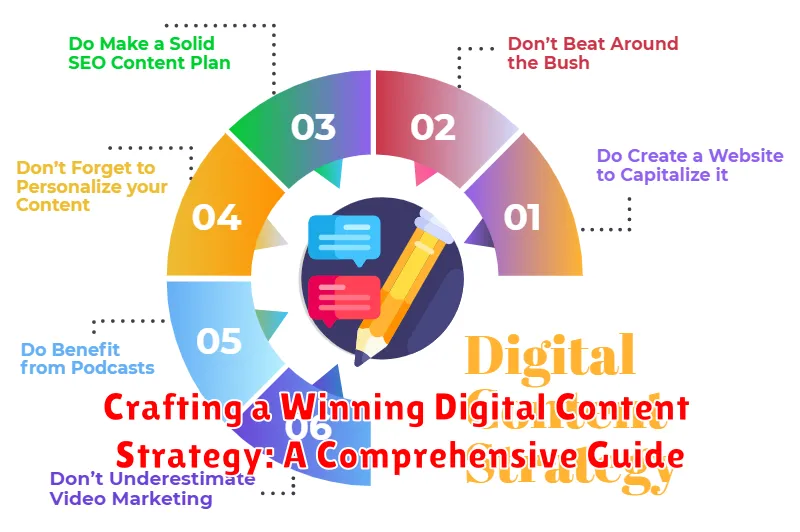In today’s digitally-driven world, a robust and effective digital content strategy is no longer a luxury but a necessity for businesses and individuals seeking to establish a strong online presence. Crafting a winning digital content strategy involves meticulous planning, consistent execution, and continuous optimization. This comprehensive guide delves into the critical components of building a successful strategy, offering actionable insights and proven techniques to help you achieve your digital marketing goals and maximize your online impact. Whether you’re looking to increase brand awareness, drive website traffic, generate leads, or boost sales, understanding the principles of a winning digital content strategy is paramount to success.
This guide will equip you with the knowledge and tools to craft a winning digital content strategy tailored to your specific needs and objectives. We’ll explore key aspects such as target audience identification, content pillar development, keyword research, content creation and distribution, performance measurement, and strategy refinement. By mastering these elements, you can transform your online presence from a passive platform into a powerful engine for growth and engagement. Prepare to embark on a journey towards digital content mastery and unlock the full potential of your online endeavors. Learn how to craft a winning digital content strategy that truly delivers.
Defining Your Target Audience and Their Needs
A crucial first step in any successful digital content strategy is defining your target audience. Understanding your audience is fundamental to creating content that resonates with them, addresses their needs, and ultimately drives desired actions.
Start by creating detailed buyer personas. These semi-fictional representations of your ideal customers should encompass demographic information (age, location, occupation), psychographic information (interests, values, lifestyle), and their online behavior (preferred platforms, content consumption habits). Consider what challenges they face and how your content can offer solutions.
Research is key. Utilize surveys, interviews, and data analytics to gain insights into your audience’s preferences. Analyze website traffic, social media engagement, and competitor analysis to understand what type of content attracts and retains your target demographic.
By accurately defining your target audience and understanding their needs, you can create content that is relevant, valuable, and engaging, laying the foundation for a winning content strategy.
Setting SMART Goals for Your Content Strategy
A successful content strategy hinges on well-defined goals. Using the SMART framework ensures your objectives are actionable and measurable. SMART stands for Specific, Measurable, Achievable, Relevant, and Time-bound. Each element plays a crucial role in shaping a successful outcome.
Specific: Clearly define what you want to achieve. Instead of a vague goal like “increase brand awareness,” aim for something specific, like “increase website traffic by 20%.” Precision is key.
Measurable: Quantify your goals. How will you track progress? Metrics like website visits, social media engagement, and lead generation provide tangible data.
Achievable: Set realistic goals within your resources and capabilities. While ambition is important, unattainable goals can be demotivating.
Relevant: Align your content goals with your overall business objectives. Ensure your content strategy contributes to the bigger picture.
Time-bound: Set a deadline for achieving your goals. This creates a sense of urgency and allows for effective performance evaluation. A specific timeframe helps maintain focus.
Conducting a Content Audit and Gap Analysis
A thorough content audit is crucial for understanding your existing content’s strengths and weaknesses. This involves cataloging every piece of content, including blog posts, articles, videos, social media updates, and website copy.
For each piece of content, document key information such as its topic, target audience, format, publication date, and key performance indicators (KPIs) like page views, engagement, and conversions.
Once your audit is complete, a gap analysis can be performed. This process involves comparing your existing content to your target audience’s needs and your content marketing goals. The gap analysis identifies areas where your content is lacking or where opportunities exist to create new, high-performing content. This analysis helps pinpoint missing topics, outdated information, and content formats that need improvement.
By understanding these gaps, you can strategically create content that fills those needs and effectively reaches your target audience.
Choosing the Right Content Formats and Channels
Selecting appropriate content formats and distribution channels is crucial for effectively reaching your target audience. Content format refers to the way your information is presented, while channel refers to where it’s published and promoted.
Consider your audience’s preferences when deciding on formats. Do they prefer short videos, in-depth articles, or visually appealing infographics? Matching the format to their consumption habits maximizes engagement.
Common content formats include:
- Blog Posts
- Videos
- Infographics
- Podcasts
- Case Studies
- Ebooks
- Social Media Updates
Channel selection should align with your target audience’s online presence. Are they active on LinkedIn, Instagram, or prefer email newsletters? Strategic channel selection ensures your content is seen by the right people.
Examples of digital channels include:
- Social Media Platforms (e.g., Facebook, Twitter, Instagram, LinkedIn)
- Email Marketing
- Your Website/Blog
- Industry Forums and Communities
Creating a Content Calendar and Workflow
A well-structured content calendar is essential for organized content creation and distribution. It acts as a central hub, providing a clear overview of scheduled posts, deadlines, and assigned team members. This organized approach facilitates consistent posting, which is crucial for audience engagement and algorithm favorability.
Begin by choosing a calendar format – spreadsheet, project management software, or dedicated content calendar tools. Populate it with planned content pieces, including titles, topics, formats, target keywords, and assigned authors. Establish a realistic publishing schedule, considering your team’s capacity and audience expectations.
Alongside the calendar, a defined workflow ensures smooth content production. This involves outlining clear steps from ideation and creation to review, editing, and publishing. A streamlined workflow minimizes bottlenecks and ensures quality control at each stage. Assigning clear roles and responsibilities within the workflow also promotes accountability and efficiency.
Optimizing Your Content for Search Engines

Search engine optimization (SEO) is crucial for ensuring your content reaches its intended audience. By optimizing your content, you increase its visibility in search engine results pages (SERPs), driving organic traffic to your website.
Keyword research forms the foundation of SEO. Identify relevant keywords and phrases your target audience uses when searching for information related to your content. Integrate these keywords naturally within your content, including in titles, headings, and body text. Avoid keyword stuffing, which can negatively impact your ranking.
On-page optimization involves optimizing elements within your content itself. This includes using descriptive meta descriptions, optimizing image alt text, and using header tags (H1-H6) to structure your content logically. A clear and organized structure improves both user experience and search engine crawlability.
Technical SEO focuses on the technical aspects of your website that affect search engine indexing. This includes ensuring your website is mobile-friendly, has a fast loading speed, and uses HTTPS. A technically sound website provides a positive user experience and signals quality to search engines.
Promoting Your Content Across Multiple Channels
Creating high-quality content is only half the battle. To maximize its impact, you need a robust promotion strategy across multiple channels. This ensures your content reaches the widest possible audience and drives desired actions.
Social media platforms offer a powerful way to engage with your target audience. Tailor your message and content format for each platform to optimize engagement.
Email marketing remains a highly effective method for nurturing leads and driving conversions. Segment your audience to deliver personalized content that resonates with their specific needs.
Consider paid advertising to amplify your reach and target specific demographics. Platforms like Google Ads and social media advertising offer granular targeting options.
Don’t underestimate the power of influencer marketing. Partnering with relevant influencers can expose your content to a wider audience and build credibility.
Measuring the Performance of Your Content Strategy

Measuring the success of your content strategy is crucial for continuous improvement and demonstrating ROI. This involves tracking key performance indicators (KPIs) aligned with your initial goals.
Website analytics provide valuable data on user behavior, such as page views, bounce rate, and time on page. These metrics can reveal which content pieces resonate with your audience and identify areas for improvement.
Social media analytics platforms offer insights into engagement, reach, and follower growth. Tracking these metrics can help you understand which platforms are most effective for your content and how your audience interacts with your brand.
SEO performance should be monitored through keyword rankings, organic traffic, and backlink profiles. These indicators demonstrate the effectiveness of your content in attracting search engine traffic.
Finally, consider using lead generation metrics such as form submissions, email sign-ups, and demo requests to measure the impact of your content on business objectives.
Staying Up-to-Date with the Latest Content Trends
The digital landscape is constantly evolving. To maintain a competitive edge, staying informed about the latest content trends is crucial. This involves continuous learning and adaptation.
Subscribing to industry newsletters and following influential thought leaders are excellent ways to stay informed. Attending webinars and conferences can provide valuable insights into emerging trends and best practices. Monitoring your competitors’ content strategies can also reveal effective tactics and potential opportunities.
Experimenting with new content formats and platforms is essential. Don’t be afraid to try short-form video, interactive content, or emerging social media platforms. Analyze the results and refine your approach based on performance data.

